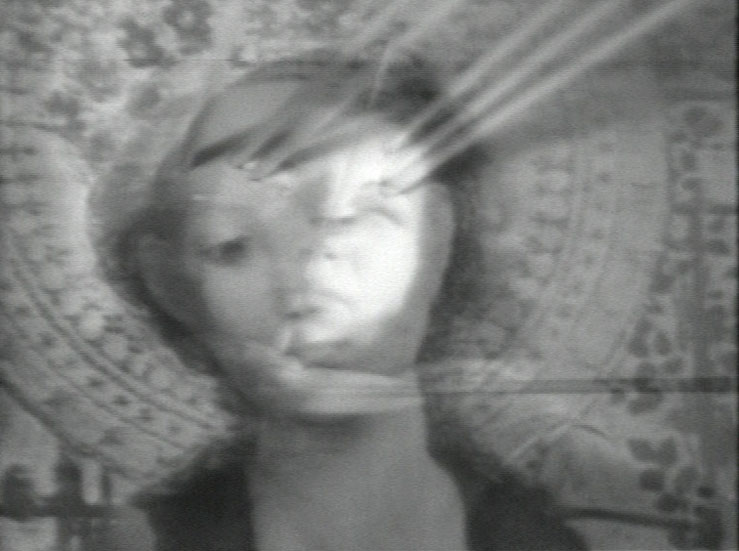 |
|
|
 |
|
The Videotape - Master or Copy? (2007)
creator(s) Martina Pfenninger (conservator)
contributor(s) videocompany.ch
The video work was recorded during a performance at the artist's studio in Düsseldorf-Oberkassel in 1975. Like the installation, it bears the title Glauben Sie nicht, dass ich eine Amazone bin. One b/w camera was directed at the artist's face while another one focussed on a detail of the target. The two signals were juxtaposed one over the other and recorded using an analogue mixer. The performing artist could watch the camera signal live on a studio monitor. The artist takes aim and shoots 15 arrows one after the other at a photo of the "Madonna im Rosenhag" by Stefan Lochner. The noise of the arrows' impact is very evident. In the background the noise of passing cars can be clearly heard.
The video work was recorded on a ½" open reel magnetic tape. The original half-inch tape was, however, damaged a little later during a public showing at the Galerie Magers stand at the "art cologne" international art fair in 1976 or 1977. Since at this time no other copies were available, a submaster for producing exhibition copies had to be made from the damaged half-inch tape. At the exhibition at the Neue Galerie – Sammlung Ludwig in 1976/77 the video work was shown for the first time with the target and colour photos as an installation. Both at the two exhibitions of the whole installation in Aachen in 1976/77 and 1986 and at the Düsseldorf Kunstmuseum from 1986 until 1993 the video was shown on U-matic. In 1980 the damaged open-reel tape was migrated to U-matic at Rosenbach's own studio. This 2nd copy generation was then distributed by the Galerie Oppenheim as a single-channel edition of 20 (without copying rights).
The resulting widespread distribution of this video work and the uncertain status of the existing tapes – are they "merely" exhibition copies or master tapes with copying rights? - make preservation a logistical problem. Thus, in the media archives of the museum kunst palast there is already a number of U-matic tapes, all of which contain the video work Glauben Sie nicht, dass ich eine Amazone bin authorised by Ulrike Rosenbach. An important research problem was, therefore, the evaluation of the condition of the existing video tapes and the challenge to redefine their status in order to preserve the best-kept tape.
In the course of the sorting work (digiBetas of the cleaned and migrated video tapes were sorted) a further video work was discovered on one of the tapes. This video was produced in 1975 during a further performance at the Oppenheim Studio in Cologne.
According to the artist this work, which can be classed as documentation, was recorded with an early colour camera by the Portapak company imported from the USA. The video is available in NTSC standard and lasts about 20 minutes. It shows clear fading to green, which according to the artist was used to boost contrast. During the recording a fault presumably occurred in the setting of the recorder (color lock), as a result of which the video signal shows interfering colour effects. This version has not been authorised as an art work but is to be preserved as a document of the performance.
Presentation:
According to the artist the video work has so far been shown inside the installation only on U-matic. Formats like U-matic and VHS are exposed to severe mechanical stress at permanent exhibitions. Picture interference such as dropouts due to abrasion of the tape material are therefore a particular feature of such video installations. One likewise common phenomenon was the slight trembling of the video signal caused during transfer from open reel to U-matic without a time base corrector (TBC).
The preservation concept of the installation provides for the video work to be migrated to an archive-proof video format with the aid of a TBC (the slight jittering of the U-matic copy would not be corrected nor amplified). Digital restoration was purposely dispensed with to keep the work as authentic as possible.
Within the installation Ulrike Rosenbach considers presentation on historical b/w studio monitors (e.g. Sony PVM) ideal. If a monitor of this kind cannot be found, the widespread modern (and mostly considered neutral) Hantarex or Barco Videowall cathode ray tube screens can be used. The objectiveness of cathode ray tube screens and the relation to the real size of a human head play a decisive role in presentation within the installation. The fact that today's monitors tend to have larger screen diagonals than studio monitors of the 70's does not bother the artist at all.
The single channel video work Glauben Sie nicht, dass ich eine Amazone bin can, says the artist, also be shown on flat screens. However, Ulrike Rosenbach flatly rejects the idea of showing this work as a projection.
Click download for evaluation of the different videotapes (PDF).
 Copyright Protected Copyright Protected
|